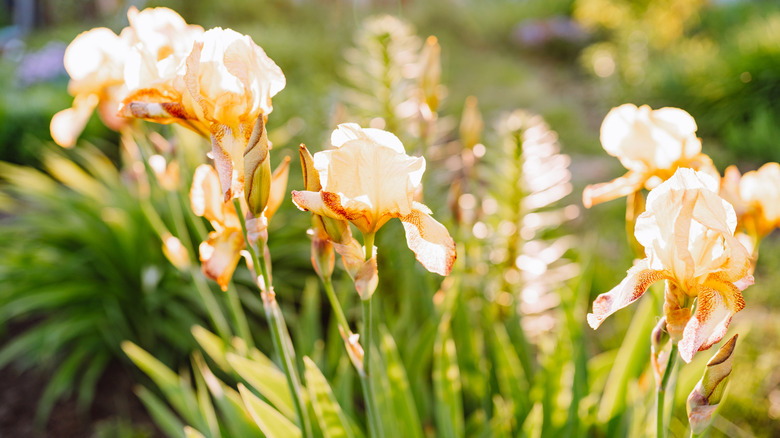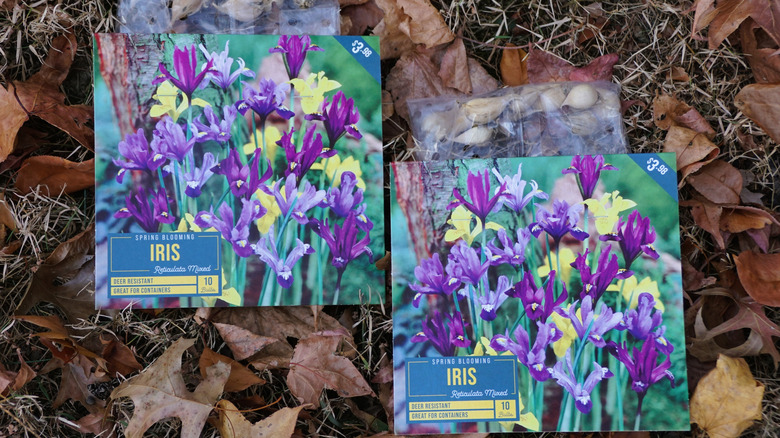Mistakes Everyone Makes When Planting Iris Bulbs
Showy irises are standouts in any flower garden, whether you use them as a border or as the star of the show. The distinct shape and petal arrangement make these flowers easy to identify, even though they're available in over 300 species with a range of colors, patterns, and sizes. Adding them to your garden is a stylish choice, especially since they're relatively easy to grow. That doesn't mean you can't make mistakes when planting iris bulbs, though. Planting at the wrong time of year or in the wrong location could affect how these flowers grow. An incorrect bulb planting depth or spacing can also keep the irises from thriving.
There are two main iris groups: bulbous and rhizomatous. Bulb irises start as traditional rounded bulbs that you completely bury. Rhizomatous varieties grow from rhizomes, which are thick horizontal root sections. It's common for iris types with larger flowers, like bearded irises, to grow from rhizomes, while smaller varieties tend to grow from bulbs. However, you'll find stunning types of irises in both groups. Make sure you know the differences in planting bulbs versus rhizomes — the timing, the depth, and the way you plant them are different.
Ignoring the correct planting time and location
Getting six to eight hours of sun daily is ideal for most irises; if your iris plants don't flower, it could be due to a lack of sunlight. However, some types do well in partial shade. The dwarf crested iris (Iris cristata), which grows in USDA zones 4 to 8, likes part sun to full shade. Choose an area that's shielded from the wind to protect taller iris plants. Research the type of iris you plan to grow to ensure you don't plant it in the wrong location.
When you're planting iris bulbs, do so in late summer or early fall. That's also the best time of year to plant tulips and other bulb flowers. The bulbs require the cold of winter to kick-start growth, but you also want to plant them early enough to allow them to establish roots before frosts arrive. For many varieties, that means planting in July, August, or September. You can plant iris bulbs even later if you live in a warm climate, as long as the overnight temperatures don't dip below 40 degrees Fahrenheit.
However, when you're planting varieties that grow from rhizomes, such as Japanese irises, get them in the soil in the spring. Rhizomes are fragile and could become damaged by extreme temperatures. Rhizomes should typically be planted right away, so nurseries often only sell them during the planting season.
Planting the iris at the wrong depth or with improper spacing
Once you choose your location and timing, you also need to consider the planting depth and spacing. Getting it wrong could prevent the flowers from growing properly. A general guideline is to leave 12 to 24 inches between the bulbs. However, the spacing recommendations vary by iris species, so check the requirements for the chosen flowers. For example, some smaller iris varieties may only need 4 inches between them. Note that you'll need to thin and divide the flowers every few years if you plant them close together.
Iris bulbs should go deep into the ground during planting — usually to a depth of 4 to 5 inches. However, the depth may vary based on the variety of iris you plant. A general guide is to plant the bulb to a depth that equals three times its height. Iris bulbs go into the ground with the roots down and the tip pointing up toward the top of the hole.
If you're planting iris rhizomes, you can easily plant them too deeply, which often cuts down on how many flowers you get or stops the plants from blooming altogether. Rhizomes shouldn't be buried completely beneath the surface — the roots go downward, but the top should stay above the soil line. Leave the top quarter of the rhizome exposed. That said, you may need to cover the tops of the rhizomes with about an inch of the growing medium if you live in a particularly hot climate.


